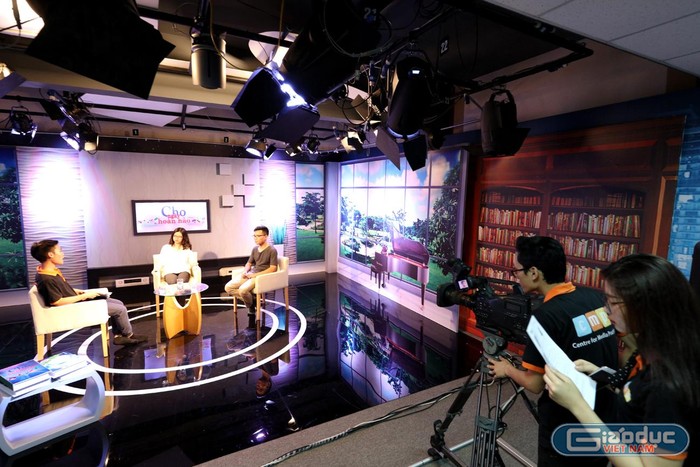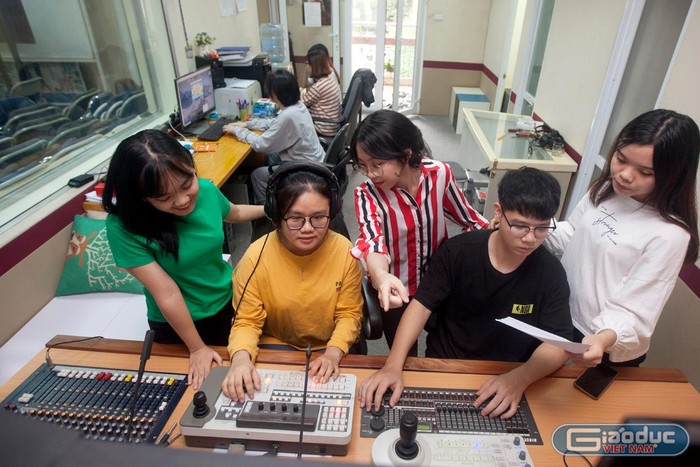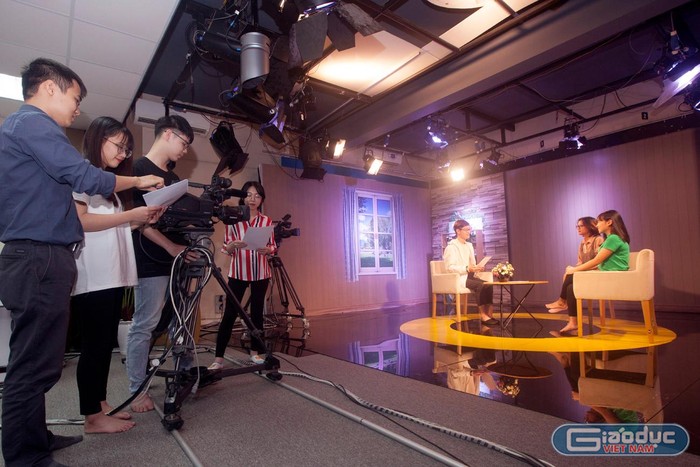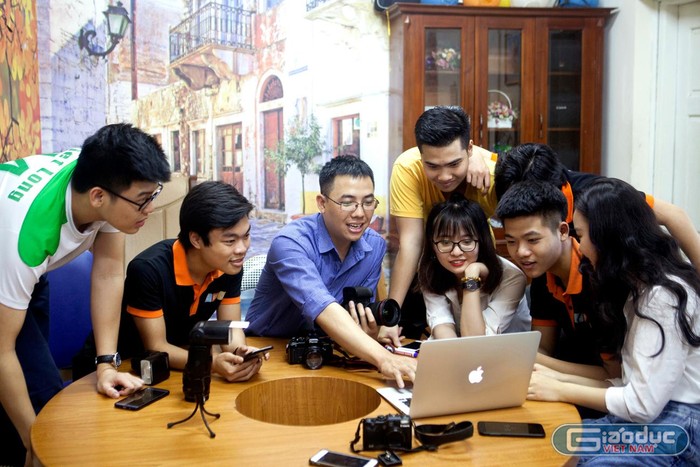Under the influence of the 4.0 technology revolution, career trends in the field of journalism and media are increasingly diverse. Journalism educators always hope that students after graduation will have enough ability to adapt to the vibrant and complex reality of this profession.
Many standard training programs integrate and add many new subjects such as data journalism, multimedia communication, mobile journalism, content organization to produce press masterpieces, etc. Some specialized courses on communication include mass media culture, social media, public relations communication, etc. These are directions to equip students with knowledge that is both broad and in-depth enough to meet the constantly changing media environment in the country and the world.
The transformation of traditional media under the development of modern science and technology will create new means and trends in journalism and communication. This is a challenge but also a requirement for journalism training institutions, not only to research trends but also to update professional knowledge and new teaching methods to meet the needs of human resources in the new social context.
Reporters of Vietnam Education Electronic Magazine had an interview with Associate Professor, Dr. Dang Thi Thu Huong - Vice Principal, Director of the Institute of Journalism and Communication, University of Social Sciences and Humanities (Vietnam National University, Hanoi).
Reporter: During the training process, how has the Institute of Journalism and Communication, University of Social Sciences and Humanities (Vietnam National University, Hanoi) connected, exchanged, supplemented, and updated training content to meet the needs of press and media agencies?
Assoc.Prof.Dr. Dang Thi Thu Huong:Training to serve the needs of society and meet the requirements of employers is one of the important training philosophies of the Institute of Journalism and Communication. The important role of press and media agencies was established right from the time our Institute built the training program, throughout the training implementation process, and was recognized when the school completed a student training cycle. Specifically, right from the time of building the program, we held seminars and talks to discuss and seek opinions from press agencies.
According to the regulations of Hanoi National University, the program can be adjusted by no more than 20% of its content each year. During the training process, we always invite experienced and veteran journalists to share their experiences and directly participate in teaching practical courses. Not only does it support students of the Institute of Journalism and Communication to have adequate practice time at press agencies, but employers also directly participate in the Graduation Thesis Evaluation Councils, or journalism products that replace graduation theses.
In recent years, the Institute has developed many new courses, such as: Graphics and design of press and media publications; Visual communication; Interactive design and multimedia animation; Journalism in emergency situations; Creation of modern press products; Multimedia communication applications; Journalism applications on mobile devices; Creation of multimedia press masterpieces; Specialized press on domestic affairs; Specialized press on economics; Specialized press on culture and society; Social issues and journalistic approaches; Management and handling of media crises...
The Institute of Journalism and Communication also has a modern and synchronized infrastructure system with real studios, virtual studios, recording studios, editing rooms, multimedia rooms, etc. to help students practice journalism and communication products as if in a miniature newsroom. The number of practical courses accounts for about 40% of the total number of specialized courses, and for many years, the Institute's students have chosen to make journalism products instead of graduation theses.
However, training is a long-term process, especially providing students with solid foundational knowledge and modern thinking methods such as self-study thinking, critical thinking, creative thinking, etc. to be able to self-improve knowledge and adapt quickly and flexibly to social changes. This is the strength of the University of Social Sciences and Humanities, the leading university in the fields of basic sciences, social sciences and humanities in the country.
 |
| Students of the Institute of Journalism and Communication in the editing room. Photo: Provided by the school. |
Reporter: There are two major trends in journalism that have been mentioned recently: specialization (to meet journalism planning) and digital transformation. How has the Institute of Journalism and Communication been preparing students to meet these requirements after graduation?
Assoc.Prof.Dr. Dang Thi Thu Huong:The school is very concerned to equip students with in-depth knowledge.
The first is to specialize in a specific field. The undergraduate journalism program at the Institute of Journalism and Communication is designed on the foundation of social sciences and humanities knowledge - the strength of the School, to help future journalists write articles with cultural depth and comprehensive social understanding.
In addition, the flexible program with many elective components helps students proactively orient their specialized journalism field. Students who later want to become domestic journalists can choose elective components from the knowledge block of political science and international relations, while students who choose courses on culture, history, art, etc. will tend to become reporters specializing in culture, or students can choose courses on psychology, sociology, economics, environment, etc.
Second, is the field of specialization. Although the Institute provides knowledge and skills in working on many types of journalism for students to help them meet the requirements of the development trend of convergent and multimedia journalism, in the 4th year, students are selected according to the following majors: Print journalism - Electronic journalism, Radio - Television, PR - Advertising and Journalism and Media Management.
The Institute of Journalism and Communication is developing a Digital Journalism and Communication program, expected to enroll students in 2023. This is also the Institute's pioneering direction to meet the strong digital transformation needs of all press agencies.
 |
| Interns during the filming. Photo: Provided by the school. |
Reporter: So what are the Institute's priorities in the coming time so that journalism training meets practical requirements, helping graduates quickly adapt to work at press agencies?
Assoc.Prof.Dr. Dang Thi Thu Huong:The journalism and media industry is changing dramatically with the rapid development of science and technology, combined with the increasing demand for information of the public in modern society, the information society, and the pressure from the emergence of many new media, such as social networks. Lecturers of the Institute of Journalism and Media always try to accumulate and systematize new knowledge to teach students, especially guiding students to work with new media formats, not only news, interviews, reports... but also Longform, Mega Story...
However, a foundation of basic, specialized knowledge, modern, positive, creative thinking methods, along with lifelong learning skills are the key factors for future journalists to be able to adapt and adapt well to the strong changes of society and the increasingly high demands of the profession. In addition, the Institute focuses on training in law and ethics of journalism and media, especially new issues of media ethics in the digital environment.
In addition to a team of well-trained lecturers, with nearly 90% having doctoral degrees, and more than half having been trained abroad, the Institute also has a team of veteran journalists with extensive experience participating as guest lecturers, and part-time lecturers with the Institute. The journalists' knowledge, skills and experience in journalism are directly transferred to students.
In addition, right from the second year, students have had long-term internships (graduation internships lasting more than 2 months) at press and media agencies, to directly absorb the hot breath of current events and immerse themselves in a real journalism environment, so that when they graduate, students will be less surprised and less confused.
The Institute has strong connections with foreign journalism and media training institutions, and has implemented many cooperation projects in building training programs such as with City University London, Stirling University (UK)... We always refine and compare with international training programs to increasingly improve the Institute's training programs.
 |
|
Students practice in the radio room. Photo: Provided by the school. |
Reporter: How does the Director compare journalism training in Vietnam and some countries in the world?
Assoc.Prof.Dr. Dang Thi Thu Huong:More than half of the lecturers at the Institute of Journalism and Communication have completed their doctoral and post-doctoral studies abroad (UK, USA, Australia, Korea, etc.), so they are always conscious of filtering and systematizing new and updated knowledge from foreign training programs to apply to teaching. In addition, one of the strict requirements of Hanoi National University in building new programs, reviewing and adjusting programs or assessing program quality is to compare and contrast the current training program with a foreign training program (among the top ranked training schools in the world).
We also learn a lot of experience in journalism training abroad, in which, focusing on skills training, paying great attention to training in journalism and media economics, and diversifying training programs, so that the training products of future journalists can adapt to the diverse needs of society. The Institute is planning to connect with universities in the region to have a mechanism to recognize each other's credits, in the future, students can diversify their learning methods in student exchange programs.
In recent years, especially journalism students have been very active. From the second and third years, they have been doing internships and collaborating with many outside agencies. At the same time, our media sector is expanding. Not only do press agencies need students trained in journalism, but other businesses also need human resources trained in the media industry.
The output for students is also more expanded than before, about 90% of students after 1 year of graduation have jobs in the field of communication, possibly in press agencies from central to local levels, or working in the communication department of ministries, departments, in the communication rooms of many businesses, event organizers...
 |
|
Students practice at the studio recording live. Photo: Provided by the school. |
35% of the Institute's teaching staff are Associate Professors, more than 60% have PhD degrees.
In 1990, the Faculty of Journalism (now the Institute of Journalism and Communication) was established. Right from the first days of its establishment, the Faculty of Journalism has gathered a team of dedicated and enthusiastic cadres and lecturers. That team, both has the profound qualities of a generation of scientists whose reputation and name have been famous in the world of theoretical criticism, both has the flamboyant and romantic qualities that have become the brand name "General Teacher", both has the sharpness, intelligence, and inspiration of masters in the use of language so that every time the teachers and students go to class, they seem to be hypnotized, and has the qualities of a journalist: quick, thorny, combative, and critical thinking...
The academic knowledge, professional experience and “General Journalism” style nurtured by the first teachers who established the Faculty of Journalism laid a solid foundation for the existence and development of the Faculty, helping the Faculty to quickly grow and soon affirm its position in the Social Sciences and Humanities sector of Hanoi National University.
Over the past 30 years, that tradition has always been nurtured and passed on, so that generations of journalists from the General Institute always remind themselves of their old school, remind themselves of the cradle that nurtured knowledge, helping them gain more courage to thoroughly identify problems and convey information to the public in the most humane way. Continuing the career of previous generations, the current teaching staff of the Institute of Journalism and Communication is mostly young, dynamic and enthusiastic, 100% of the lecturers have a master's degree or higher, of which 35% of the Institute's teaching staff are Associate Professors, more than 60% have a PhD. Many staff have received professional training in the Soviet Union, England, Australia, Korea, Russia... and are prestigious experts in the academic and research fields of journalism and communication nationwide.
In the leading training and research environment of Social Sciences and Humanities in Vietnam, students of the Institute are exposed to and are imparted with the most basic, fundamental and profound knowledge of Social Sciences and Humanities, important and valuable knowledge foundations that help future journalists write many articles that touch people's hearts with cultural depth and comprehensive social understanding.
 |
|
Associate Professor, Dr. Dang Thi Thu Huong (right) presents graduation certificates to students. Photo: Provided by the school |
From this school, more than 10,000 bachelors, masters, and doctors of journalism have spread to all parts of the country, working and contributing news streams, creating a seamless flow in society. Many alumni are journalists who are always on the front lines during difficult times of storms, floods, and natural disasters. Many journalists are leading writers in the fight against corruption and negativity. Hundreds of alumni have received the National Press Award and national press awards from various sectors and levels. Many alumni have held and are holding key positions in the country's press and media system.
Training programs are constantly being innovated and updated.
Training and research on journalism in the context of modern media, the context of media explosion, teaching about new media, convergent and multimedia media, social media, the development of modern journalism in the new media environment... are important contents taught at the Institute of Journalism and Communication. In the spirit of continuous innovation, the Institute's training program has been supplemented with many new and modern subjects such as: Mobile journalism; Data journalism; Organizing content and creating journalistic masterpieces; Reporting in emergency situations, and other specialized fields of journalism.
Currently, the Institute of Journalism and Communication has been training undergraduate, postgraduate and doctoral students. In addition to the undergraduate programs in Journalism, Journalism (high quality) and Public Relations, the Institute is implementing Master's training in Journalism (research-oriented and application-oriented), Journalism and Communication Management and a joint program in Communication Management (with Stirling University, UK)...
The number of students enrolled in the Institute's training programs has always been in the top 3 programs with the largest number of students and trainees registered for many consecutive years and has led the entire school in graduate enrollment, including 5 graduate classes in localities across the country.
 |
|
Students interact with electronic press works. Photo: Provided by the school. |
The Institute is one of the international exchange hubs in journalism and media research and training in Vietnam, with cooperative relationships with many foreign press organizations and leading journalism training institutions in the world. Many cooperation projects have been implemented, resulting in the publication of many monographs, dozens of staff members receiving advanced training at home and abroad, and the training program framework for Journalism and Public Relations has been gradually revised and improved to suit the development trends of the world and Vietnam's media industry. The Institute has also established a specialized bookshelf in foreign languages with more than 100 books to serve journalism and media training and research.
In 2018, on the basis of integrating the Faculty of Journalism and Communication and the Center for Journalism and Communication, the Institute of Journalism and Communication was established, marking a milestone as a pioneer unit in the University of Social Sciences and Humanities, Hanoi, developing from a faculty to an Institute, preparing the premise for university autonomy in the future.
Sincere thanks to Associate Professor, Dr. Dang Thi Thu Huong.
Author:Tung Duong
Newer news
Older news